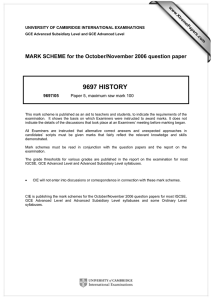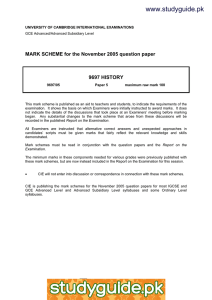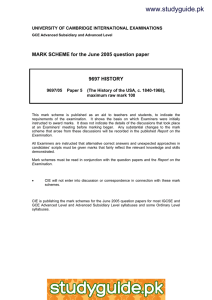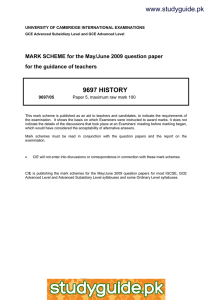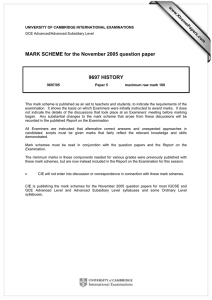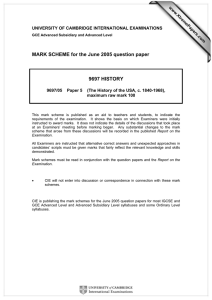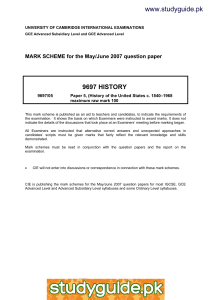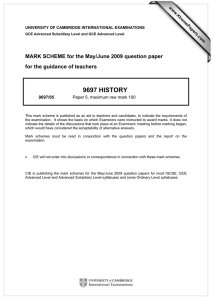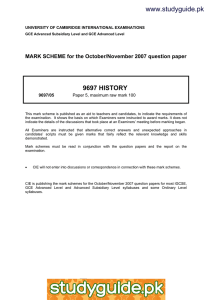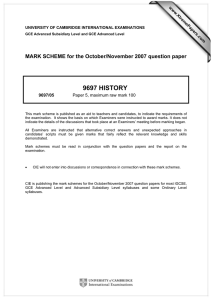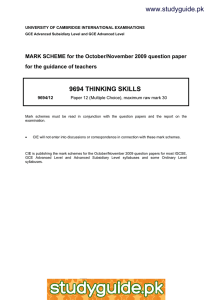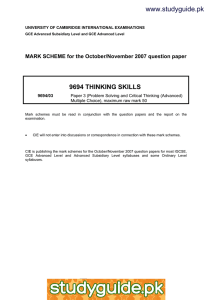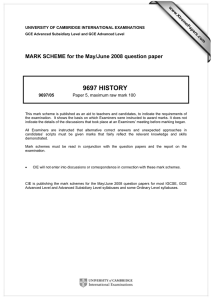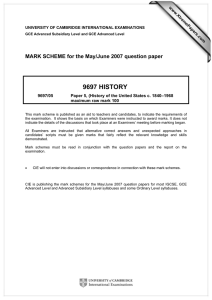www.studyguide.pk 9697 HISTORY
advertisement
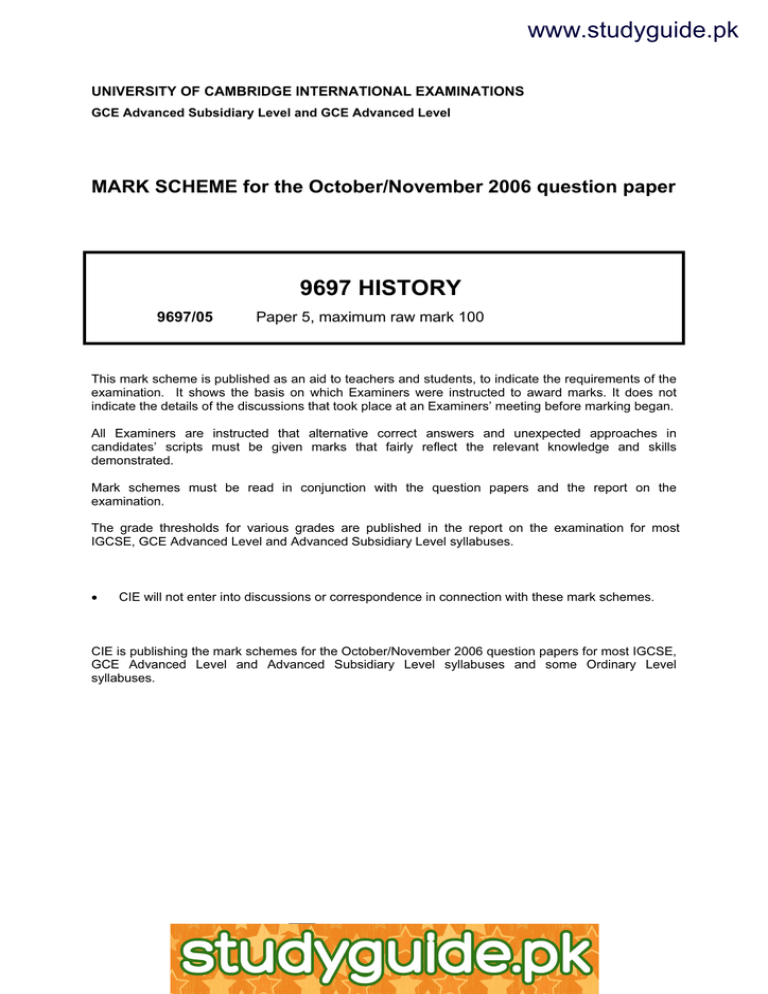
www.studyguide.pk UNIVERSITY OF CAMBRIDGE INTERNATIONAL EXAMINATIONS GCE Advanced Subsidiary Level and GCE Advanced Level MARK SCHEME for the October/November 2006 question paper 9697 HISTORY 9697/05 Paper 5, maximum raw mark 100 This mark scheme is published as an aid to teachers and students, to indicate the requirements of the examination. It shows the basis on which Examiners were instructed to award marks. It does not indicate the details of the discussions that took place at an Examiners’ meeting before marking began. All Examiners are instructed that alternative correct answers and unexpected approaches in candidates’ scripts must be given marks that fairly reflect the relevant knowledge and skills demonstrated. Mark schemes must be read in conjunction with the question papers and the report on the examination. The grade thresholds for various grades are published in the report on the examination for most IGCSE, GCE Advanced Level and Advanced Subsidiary Level syllabuses. • CIE will not enter into discussions or correspondence in connection with these mark schemes. CIE is publishing the mark schemes for the October/November 2006 question papers for most IGCSE, GCE Advanced Level and Advanced Subsidiary Level syllabuses and some Ordinary Level syllabuses. www.xtremepapers.net www.studyguide.pk Page 2 Mark Scheme GCE A/AS LEVEL - OCT/NOV 2006 Syllabus 9697 Paper 5 HISTORY OF THE UNITED STATES c. 1840-1968 Note: All Questions are to be marked using the generic marking bands for sourcebased and essay questions. SECTION A 1 SOURCE BASED QUESTION The 1850 Compromise L1 WRITES ABOUT THE HYPOTHESIS, NO USE OF SOURCES These answers will write about the 1850 Compromise but will ignore the question i.e. they will not use the Sources as information/evidence to test the given hypothesis. Include in this level answers which use information taken from the Sources but only in providing a summary of views expressed by the writers, rather than for testing the hypothesis. L2 USES INFORMATION TAKEN FROM THE SOURCES TO CHALLENGE OR SUPPORT THE HYPOTHESIS These answers use the Sources as information rather than as evidence i.e. sources are taken at face value only with no evaluation/interpretation in context. [1-5] [6-9] The Compromise was satisfactory. Source D says, Georgia will abide by it as it is ‘permanent adjustment’. Also Source E says that it was satisfactory ‘both North and South got same thing from it. Or alternatively in Source B Calhoun states that Clay cannot save the Union with this compromise. L3 L4 USES INFORMATION TAKEN FROM SOURCES TO CHALLENGE AND SUPPORT THE HYPOTHESIS These answers will include both the supporting and the challenging evidence quoting from the relevant Sources. However, these are used only at face value. BY INTERPRETING/EVALUATING SOURCES IN CONTEXT, FINDS EVIDENCE TO CHALLENGE OR SUPPORT THE HYPOTHESIS These answers are capable of using Sources as evidence in demonstrating their utility in testing the hypothesis, by interpreting them in their historical context i.e. not simply accepting them at face value. [10-14] [15-17] For example; the 1850 Compromise simply postponed conflict for a decade by papering over the cracks. Source B makes it clear that the Fugitive Slave Law was crucial for the South, yet Source E states that the North was not prepared to accept its implementation. Both the Dred Scott case and the John Brown Raid were concerned with slaves fleeing from captivity and both provoked heightened tension. L5 BY INTERPRETING/EVALUATING SOURCES IN CONTEXT, FINDS EVIDENCE TO CHALLENGE AND SUPPORT THE HYPOTHESIS These answers know that testing the hypothesis involves attempting both to confirm and disconfirm the hypothesis, and are capable of using Sources as evidence to do this (i.e. both confirmation and disconfirmation are done at this level). For example; L4 plus Source E confides that the Compromise did buy time, hence averted conflict for a decade. Candidates may agree that Sources A and D demonstrate that had the terms of the Compromise been adhered to, then conflict would have been averted, but extraneous events such as the Kansas/Nebraska controversy introduced new elements which undermined it fatally. © UCLES 2006 www.xtremepapers.net [18-22] www.studyguide.pk Page 3 L6 Mark Scheme GCE A/AS LEVEL - OCT/NOV 2006 Syllabus 9697 AS LEVEL 5, PLUS EITHER (A) EXPLAIN WHY EVIDENCE TO CHALLENGE/SUPPORT IS BETTER/PREFERRED, OR (B) RECONCILES/EXPLAINS PROBLEMS IN THE EVIDENCE TO SHOW THAT NEITHER CHALLENGE NOR SUPPORT IS TO BE PREFERRED. For (A) the argument must be that the evidence for challenging or supporting the claim is more justified. This must involve a comparative judgement i.e. not just why some evidence is better, but also why some evidence is worse. For (B) include all Level 5 answers which use the evidence to modify the hypothesis (rather than simply seeking to contradict/support it) in order to improve it. For example candidates may choose to explore what “satisfactorily resolve” means in this context, and the extent to which expectation and attitudes changes in the late 1850s. SECTION B ESSAY QUESTIONS These are marked applying the Generic Marking Bands scheme published by Cambridge International Examinations. 2 Explain how and why the belief in America’s Manifest Destiny proved so strong in the 1840s and 1850s. “How” and “why” should be clearly distinguished and failure to do so will lead to 15 at best. The basic tenets of, and background to, “Manifest Destiny” need spelling out; that Providence had intended the US to control the entire North American landmass. The concern for national security against Britain needs spelling out, as does the fact that the Mexican state was too weak to resist American incursions. Stronger candidates will draw attention to the role of better communications in the form of railroads, and the lure of cheap and limitless land in the West provided a means for immigrants to better themselves. One would expect some discussion as to what extent the idealistic element in the Doctrine was merely a cloak for less lofty motives of greed, racism and exploitation. The impact of the Doctrine on the explosive slavery expansion question and on the Native American nations should be examined. High quality answers will be consistently analytical, well argued and with high quality supporting material relevantly deployed and will score (21-25). Good answers (1820) will be mostly analytical/explanatory but with some unevenness in structure of argument and the quality of supporting material. Bare pass answers (11-15) will be largely descriptive or narrative and relevance and accuracy may stray. 3 ‘Johnson’s real offence was his constant determination to thwart the will of Congress as expressed in the Reconstruction Acts.’ How far does this explain his opponents’ efforts to remove him from office? Johnson was in an impossible position. He was the only Southerner remaining in the Senate and loyal to the Union after Secession; he was also a Democrat and was the ideal candidate as VP to Lincoln to help win over “war Democrats” in the 1864 election. The murder of Lincoln by a Southerner brought him to the Presidency just after America’s bloodiest ever war when the desire to punish the rebels of the South was at its highest point. Johnson attempted to continue Lincoln’s conciliatory Reconstruction policy insisting that it was a Presidential power, not a Congressional one. However he went much further in his overt sympathy with Southern whites and appeared indifferent to the social, economic and political advancement of the Freedmen. Allied to this was obstinacy and unwillingness to compromise and lack of political skills e.g. in attempting to veto Bills and Constitutional Amendments passed overwhelmingly by © UCLES 2006 www.xtremepapers.net Paper 5 [23-25] www.studyguide.pk Page 4 Mark Scheme GCE A/AS LEVEL - OCT/NOV 2006 Syllabus 9697 both Houses of Congress. After the 1866 elections the Radical Republicans were completely dominant and there was a determination to get rid of Johnson’s obstruction and replace him with Wade, the Radical, who as President pre temp of the Senate, would replace him as President of the United States. High quality answers will be consistently analytical, well argued and with high quality supporting material relevantly deployed and will score 21-25. Good answers (1820) will be mostly analytical/explanatory but with some unevenness in structure of argument and the quality of supporting material. Bare pass answers (11-15) will be largely descriptive or narrative and relevance and accuracy may stray. 4 How far is it justified to speak of an agrarian revolt among American farmers in the period 1865 to 1896? Responses need to be fully able to distinguish between international factors (overproduction) and domestic (railroads, high interest rates) which all tended to depress severely prices of crops, and increase indebtedness of farmers. The impact often fell most acutely on the poorest area (the South) and the vast number of marginal small farmers who had received virtually free land under the Homestead Act. Candidates need to trace the development of the Grainger Movement, later the People’s Party, and should show awareness of the reasons for their failure. Better candidates will point out that many aspects of the Populists’ programme were eventually adopted into law. The terminal date (1896) marks the first of William Jennings Bryan’s attempts on the Presidency when his programme was so similar to the Populists particularly on the vexed silver question that he was adopted by them as their official candidate for the Presidency. High quality answers will be consistently analytical, well argued and with high quality supporting material relevantly deployed and will score 21-25. Good answers (1820) will be mostly analytical/explanatory but with some unevenness in structure of argument and the quality of supporting material. Bare pass answers (11-15) will be largely descriptive or narrative and relevance and accuracy may stray. 5 Compare Martin Luther King and Malcolm X as leaders of the Civil Rights Movement of the1950s and 1960s. Will be very popular but answers require careful planning. King has been elevated to the American Pantheon and is the only non-President to have a national holiday named after him. He remains above criticism and this may be reflected in responses. Clearly he was enormously talented seeing clearly the opportunities offered by the Brown judgement of the Supreme Court which in essence declared all discrimination within public places illegal, and by the new wave of Democratic leaders, and the opportunities offered by the medium of television. Martin Luther King, as well as Lyndon Baines Johnson, was the inspiration of the Civil Rights Act and the accompanying Voting Rights Act which between them opened the franchise to the Southern Blacks. King’s grasp of public relations was masterly and he realised the importance of being seen as law abiding. His argument that there was a higher moral law that should prevail over unjust State and local laws enabled him to break the latter while retaining his non-violent reputation. He skilfully used the relatively new product of television to win new allies in the North and the nation was shocked by the widely televised actions of men such as ‘Bull’ Connor and his fierce dogs attacking peaceful demonstrators including women and children. By skilful cultivation of Democratic politicians he was able to persuade them to be more active in their support for Civil Rights. JFK’s election in 1960 was probably due to the candidate phoning Mrs King while Martin Luther King was in gaol. Martin Luther King’s powers of oratory were spectacularly successful. Malcolm X was quite different; a different religion (Islam), no attempt to woo white liberals or politicians, whom he regarded with contempt; also a specific rejection of non-violence (the key to Martin Luther King’s creed) though stopping short of © UCLES 2006 www.xtremepapers.net Paper 5 www.studyguide.pk Page 5 Mark Scheme GCE A/AS LEVEL - OCT/NOV 2006 Syllabus 9697 endorsing violence. He urged separation rather than integration. His appeal was to the large impoverished Afro-American population of the big cities while King’s was to Southern Blacks. Malcolm was able to strike a response from among the large number of younger and more radical Blacks who felt that they had gained very little in concrete socio-economic terms from the constitutional and Civil Rights legislation. Moreover the Vietnam War was poisoning the political atmosphere. Even King came out against it, but to Malcolm X it was a White Man’s war fought with Black lives to kill yellow men; he was the most articulate spokesman of the “black power” movements which swept across America in the 1960s. Assassination cut short both their young lives. King’s reputation has not only endured but he has acquired iconic status; however Malcolm X pointed out to the white political leaders the stark consequences of delaying any further progress in Civil Rights. High quality answers will be consistently analytical, well argued and with high quality supporting material relevantly deployed and will score 21-25. Good answers (1820) will be mostly analytical/explanatory but with some unevenness in structure of argument and the quality of supporting material. Bare pass answers (11-15) will be largely descriptive or narrative and relevance and accuracy may stray. 6 Evaluate the impact of the Depression on American Society, 1929-1939 Relevance is important here and the emphasis should be on social rather than political impact. Few actually starved but malnutrition conditions prevailed; the death rate actually fell due to medical advances; immigration fell and with it population growth slowed; there was a sharp rise in vagrancy estimated at 5 million. The effects on small business and the professional classes were dramatic and graduate unemployment soared; there was an exodus from the land; the effect on black areas was catastrophic – by 1935 at least 30% of black families were on relief, Afro-Americans became strong supporters of the New Deal and for the first time acquired posts in the Federal Administration. The lot of Native Americans was dire; and only the very rich were little affected; education suffered badly, church membership actually fell, there was a large increase in economic crimes such as theft but not violent crime. There was an enormous increase in radio coverage with 86% of families having one by 1940. Though the nation was solidly behind FDR and the New Deal in all elections from 1932 onwards it should be noted that unemployment remained very high until the end of the period. High quality answers will be consistently analytical, well argued and with high quality supporting material relevantly deployed and will score 21-25. Good answers (1820) will be mostly analytical/explanatory but with some unevenness in structure of argument and the quality of supporting material. Bare pass answers (11-15) will be largely descriptive or narrative and relevance and accuracy may stray. 7 Why, in spite of President Wilson’s policy of neutrality, did America enter the war in 1917? Best approach is to distinguish two quite different questions: 1) why did US declare neutrality in August 1914? 2) Why did it then declare war in 1917 as an associated power of Britain and France? The US had no direct interest at stake in the conflict so neutrality made sense, though its northern neighbour Canada was a belligerent. However, US neutrality was always one sided and grew increasingly so as the war progressed. The social and political elites were always pro Ally. By 1917 it could be argued that the US could not afford an allied defeat. With the collapse of Russia in 1917, a German victory on the Western front became increasingly likely. With reluctance the US condoned the British naval blockade of Atlantic sea traffic. The US sold war materials to the Allies (but not to the Central Powers). By 1916 US and Allied interests were closely intertwined so that submarine warfare from Germany was seen as an intolerable affront leading to the tragedy of the sinking of the Lusitania. The turning points for America were the resumption of unrestricted © UCLES 2006 www.xtremepapers.net Paper 5 www.studyguide.pk Page 6 Mark Scheme GCE A/AS LEVEL - OCT/NOV 2006 Syllabus 9697 submarine warfare by Germany and the Zimmerman telegram. Though Wilson said it was war for democracy other factors were clearly present. High quality answers will be consistently analytical, well argued and with high quality supporting material relevantly deployed and will score 21-25. Good answers (1820) will be mostly analytical/explanatory but with some unevenness in structure of argument and the quality of supporting material. Bare pass answers (11-15) will be largely descriptive or narrative and relevance and accuracy may stray. 8 Assess the consequences from 1945 to1968 of the great expansion of higher education in the United States. By 1970 there were 7.5 million university students, a huge increase triggered off initially by GI Bill. The main consequences were: 1. As universities became larger they became more bureaucratic and impersonal. 2. They became increasingly dependent on Government grants and grants from business. There were sharp clashes involving outdated regulations on lifestyles between students and administrations. 3. There was a fall in academic standards at the lower level of Universities. 4. The Vietnam war and the Draft of young conscripts to fight it triggered off a rebellion and mass protests at nearly all campuses in the country. High quality answers will be consistently analytical, well argued and with high quality supporting material relevantly deployed and will score 21-25. Good answers (1820) will be mostly analytical/explanatory but with some unevenness in structure of argument and the quality of supporting material. Bare pass answers (11-15) will be largely descriptive or narrative and relevance and accuracy may stray. © UCLES 2006 www.xtremepapers.net Paper 5
